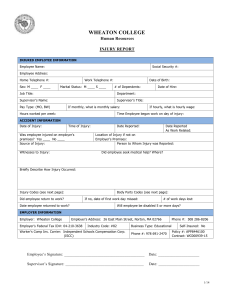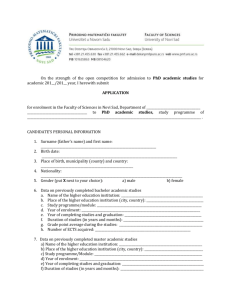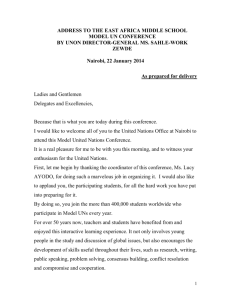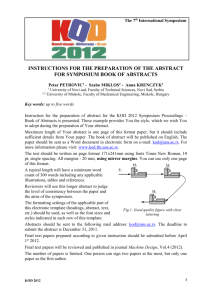BANCO DE PORTUGAL Economic Research Department Daniel Dias Carlos Robalo Marques
advertisement
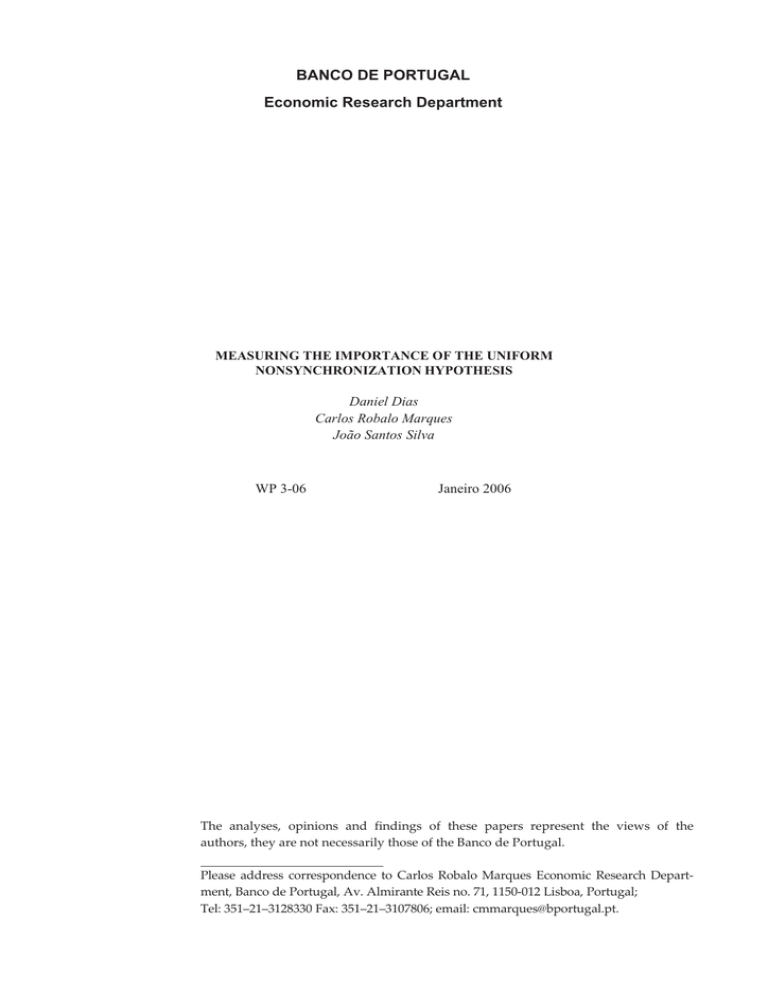
BANCO DE PORTUGAL Economic Research Department MEASURING THE IMPORTANCE OF THE UNIFORM NONSYNCHRONIZATION HYPOTHESIS Daniel Dias Carlos Robalo Marques João Santos Silva WP 3-06 Janeiro 2006 The analyses, opinions and findings of these papers represent the views of the authors, they are not necessarily those of the Banco de Portugal. Please address correspondence to Carlos Robalo Marques Economic Research Department, Banco de Portugal, Av. Almirante Reis no. 71, 1150-012 Lisboa, Portugal; Tel: 351–21–3128330 Fax: 351–21–3107806; email: cmmarques@bportugal.pt. Measuring the importance of the uniform nonsynchronization hypothesis D.A: Diasy, C: Robalo Marquesz, J.M.C: Santos Silvax Abstract In this paper we critically reappraise some measures of the importance of timedependent price setting rules and propose an alternative way to gauge the signi…cance of this type of price setting behaviour. The merits of the proposed measure are highlighted in an application using micro-data. Our results suggest that a large proportion of price trajectories may be compatible with simple time-dependent price setting mechanisms but the strength of this evidence very much depends on the way that is used to evaluate the importance of this type of behaviour. JEL classi…cation codes: D40, E31, L11. Key Words: Time-dependent price setting models, uniform staggering, perfect synchronization We are grateful to Pedro Duarte Neves for helpful discussions and suggestions. Pete Klenow kindly provided the U.S: data used in the examples. The usual disclaimer applies. João Santos Silva is thankful for the hospitality, working conditions and …nancial support provided by Banco de Portugal and gratefully acknowledges the partial …nancial support from Fundação para a Ciência e Tecnologia, program POCTI, partially funded by FEDER. y Banco de Portugal and Anderson School of Management, UCLA. E-mail: ddias@anderson.ucla.edu. z Banco de Portugal. E-mail: cmrmarques@bportugal.pt. x ISEG/Universidade Técnica de Lisboa. E-mail: jmcss@iseg.utl.pt. 1 1. INTRODUCTION The type of price setting mechanism to use is a major issue in the speci…cation of any macroeconomic model. Time-dependent price setting mechanisms, like the ones proposed by Taylor (1980) and Calvo (1983), are often used due to their simplicity. In its basic version, the model proposed by Taylor (1980) implies that the share of prices that changes each period is constant. Cecchetti (1985, p: 940) termed this the uniform nonsynchronization (UNS) hypothesis.1 Even if simple time-dependent price setting mechanisms characterized by UNS do not provide a valid description of the whole economy, it might be the case that the fraction of prices that change every period varies little over time. In this situation, macroeconomic models based on the UNS hypothesis may lead to results that do not di¤er much from the ones obtained using state-dependent price setting schemes. This idea is explored by Klenow and Kryvtsov (2005). These authors have devised a statistic which can be interpreted as a measure of the degree of UNS, and compared the results of a model using time-dependent price setting with the results of a state-dependent model calibrated to produce a value of their statistic similar to that found using the USA data. The results of Klenow and Kryvtsov (2005) suggest that the di¤erences between the two models are negligible. Although the line of research pioneered by Klenow and Kryvtsov (2005) is potentially very fruitful, the results depend critically on the way the importance of time-dependent price setting schemes is measured. In this paper, we argue that some caution is needed in the use of the statistic proposed by Klenow and Kryvtsov (2005) as a measure of the degree of UNS. Furthermore, we build on the work of Dias, Marques, Neves and Santos Silva (2005) to propose an alternative way to measure the signi…cance of UNS. It is important to realize that all the statistics considered here measure only the importance of price-setting rules implying UNS. Therefore, they provide no information 1 Uniform nonsynchronization is also termed uniform staggering (see, for instance, Fisher and Konieczny, 2000), uniform price staggering (see, Dias et al., 2005) or perfect staggering (see, for instance, Aucremanne and Dhyne, 2004). 2 on the importance of other forms of time-dependent price setting rules. On the other hand, it is also important to point out that, even if these statistics indicate that UNS provides a good description of the price setting rules in the economy, that does not mean that indeed time-dependent rules are used. What matters is that, whatever the way prices are set, their behaviour mimics what happens in an economy where UNS is important. The remainder of this paper is organized as follows. The next section critically reviews the way Klenow and Kryvtsov (2005) measure the signi…cance of time-dependent price setting mechanisms. In Section 3 we use the results in Dias et al: (2005) to obtain a measure of the importance of time-dependent price setting mechanisms implying UNS, and suggest an alternative approach to this problem. Section 4 describes the data available to us and provides the empirical results obtained with the di¤erent measures. Finally, Section 5 concludes. 2. MEASURING UNS: THE METHOD OF KLENOW AND KRYVTSOV Klenow and Kryvtsov (2005) proposed a simple and ingenious method to measure the importance of time-dependent price setting mechanisms. Their method is based on a decomposition of the variance of in‡ation into two components. The …rst, depends on the variance of the average magnitude of price changes and re‡ects changes in the intensive margin. The second, depends on the variance of the fraction of items changing price and on the covariance between the magnitude of price changes and the fraction of items changing price. Essentially, this second term captures changes in the extensive margin. Speci…cally, let t be the in‡ation rate in period t and denote by t the average rate of price changes across all …rms in period t, conditional on a price change having occurred. Furthermore, de…ne E ( t ) = V ar [ t ] = V ar [ t t] and E ( t ) = . Klenow and Kryvtsov (2005) notice that and therefore V ar [ t ] = V ar [ = 2 t +( t ) t] V ar [ t ] + V ar [( t 3 ) t ] + 2Cov [ t; ( t ) t] . 2 Klenow and Kryvtsov (2005) de…ne V ar [ t ] as the time-dependent component of the in‡ation variance because that would be the value of V ar [ t ] for t = . Given this split of the variance of in‡ation, Klenow and Kryvtsov (2005) use the ratio between the time-dependent component of the in‡ation variance and the total variance of t, that is, 2 KK = V ar [ t ] , V ar [ t ] (1) as a measure of the importance of time-dependent price setting schemes. In practice, an estimator of KK , say [ KK , can be obtained by replacing in (1) , V ar [ t ] and V ar [ t ] by the respective sample counterparts. At this point, it is important to carefully consider the meaning of Kryvtsov (2005, p:11) state that 2 KK . Klenow and V ar [ t ] captures changes in the intensive margin, which account for all of the variation in in‡ation in staggered time-dependent models. However, it is important to notice that the type staggering that implies V ar [ t ] = 2 V ar [ t ] is UNS, for which t = , 8t. The authors go on to claim that the other two terms involve changes in the extensive margin, which only contribute in state-dependent models. However, time-dependent models à la Calvo (1983) also imply changes in the extensive margin because in these models t varies randomly around . Therefore, these two other terms capture not only the importance of state-dependent rules, but also the contribution for the variance of the in‡ation from time-dependent rules that do not imply UNS. Therefore, at best, KK is a measure of the importance (for the variance of the in- ‡ation) of time-dependent price setting rules that imply UNS, rather than a measure of the importance of time-dependent rules tout court. This view is in a way con…rmed by Klenow and Kryvtsov (2005, pp: 11-12), who explicitly use this term in their variance decomposition to draw conclusions about the importance of ‡uctuation in about the degree of UNS. However, the interpretation of KK t, that is, as a measure of the degree of UNS is marred by some di¢ culties, which we now enumerate.2 2 By de…nition, the so-called time-dependent term in the variance decomposition of in‡ation measures the contribution of the variation in the average size of price changes (changes in the intensive margin) to the variance of in‡ation. Our criticism of KK only applies to its use as a measure of the importance 4 1. Perhaps the more obvious ‡aw of interval. Indeed, if V ar [( particular, KK t KK is that it is not constrained to be in the [0; 1] ) t ] + 2Cov [ t; ( t ) t ] < 0, then = 1 for V ar [ t ] = 0. Consequently, KK KK > 1. In cannot be seen as a proportion. 2. A related problem is that values of KK close to 1 do not necessarily imply a high degree of UNS. Indeed, for V ar [ t ] > 0, UNS implies converse is not true. Indeed, all that is required for V ar [( ) t ] + 2Cov [ t 3. The value of KK t; ( t KK depends on the mean of t to be equal to 1 is that KK t, which has little to do with the is shifted by a constant, say , the numerator will remain constant, whereas the denominator becomes V ar [ which in general is di¤erent from V ar [ 4. Finally, = 1 but the ) t ] = 0. importance of UNS. In particular, if of KK KK t t + t ], t t] also depends on the variance of t. Speci…cally, V ar [ t ] passes to 0. In the limit, for constant t, KK KK tends to 0 when will be zero, whether or not UNS is important (as long as V ar [ t ] > 0). On the other hand, a pure statedependent economy, where the degree of UNS is zero, will not be characterized by a value of KK equal to zero (unless t is constant). These facts make clear that, by itself, the estimated value of KK may have little to do with the importance of UNS in the economy. In the particular application considered by Klenow and Kryvtsov (2005), these pitfalls of KK are somewhat mitigated by the fact that the covariance term is generally small. Nevertheless, the authors report some values for their statistic which are higher than one, highlighting the di¢ culties with its interpretation.3 In other applications, there is no guarantee that the covariance term will be negligible and therefore the use of The source of the problems with KK KK requires some caution. can be traced back to the fact that a ratio measuring the importance for the variance of in‡ation of changes in the intensive margin of the degree of UNS, and not to its use as a measure of the importance of changes in the intensive margin to the variance of in‡ation. 3 Below, we provide an example in which [ KK = 1:30. 5 is being interpreted as a measure of the importance of UNS. This makes KK dependent on characteristics of the economy (e.g., V ar [ t ]) which are only indirectly related to the topic of interest, viz., the ‡uctuations in the fraction of items changing price. Given these limitations of KK as a measure of UNS, it is interesting to study alternative forms of gauging the importance of this type of price setting rules. 3. MEASURING UNS: OTHER METHODS Rather than measuring the importance of UNS by its contribution to the variance of the in‡ation, here we follow Dias et al: (2005) and evaluate the importance of UNS by the proportion of prices in the economy that are set using time-dependent rules that imply UNS. Of course, these new statistics will not allow us to measure the contribution of UNS for the variance of in‡ation, but they have the advantage of depending only on the variability of t. As in Dias et al: (2005), suppose that the economy is characterized by a mixture of two types of …rms. Firms of type 1 are characterized by UNS, with a …xed proportion of …rms adjusting their prices every period (as in Taylor, 1980, p: 4). Let proportion of …rms of type 1 in the economy and de…ne 1 denote the as the fraction of this type of …rms that adjust their prices in a given period. For type 2 …rms, UNS does not hold and therefore the share of these …rms that adjusts their prices in period t varies. Let st denote the proportion of type 2 …rms that change prices in period t. Under these circumstances, t, the fraction of prices that change in period t for the whole economy is given by4 t This model for t = 1 + (1 nests two polar cases. For UNS. On the other hand, for We take the value of ) st . (2) = 1, the economy is characterised by = 0, no price is set by time-dependent rules implying UNS. as a measure of the importance of price setting rules implying UNS and, in what follows, we discuss how to obtain information on this parameter. 4 To provide a link with the results of Klenow and Kryvstov (2005), it is interesting to notice that if (2) is substituted into V ar [ t ], = 1 implies KK = 1 for V ar [ t ] > 0. 6 3.1 The F K index Dias et al: (2005) have studied the case in which …rms of type 2 have perfect price synchronization as de…ned by Fisher and Konieczny (2000).5 In this case, st is a Bernoulli random variable with E(st ) = 2, say. If, for simplicity, we assume that have E( t ) = and V ar [ t ] = (1 1 = 2 = , we )2 . Dias et al: (2005) show that under these ) (1 assumptions the proportion of …rms with perfect price synchronization can be estimated by the Fisher and Konieczny (2000) synchronization index de…ned as s V ar[^t ] FK = , 1 with and V ar[^t ] denoting respectively the sample mean and the sample variance of ^t (see Dias et al., 2005). Consequently, in this economy, the proportion of …rms whose price setting behaviour is characterized by UNS can be estimated by d FK = 1 F K. Clearly, d F K has some important advantages over [ KK as a way of measuring the im- portance of time-dependent price setting mechanisms with UNS. Indeed, besides having a clear interpretation, it is restricted to the [0; 1] interval. Moreover, unlike [ KK , d FK does not depend on the properties of t, the average rate of price changes in period t, conditional on a price change having occurred. Despite these attractive features, d F K also has some drawbacks which are related to the fact that it is based on a statistics whose purpose is to measure the degree of perfect price synchronization rather than the degree of UNS. Indeed, if type 2 …rms are not perfectly synchronized, st is a random variable with domain [0; 1] rather than a Bernoulli variable with support in f0; 1g. In this case d F K will be biased upwards because V ar [ t ] will be smaller than (1 ) (1 )2 . Since this is generally the case, d F K should be viewed as an upper bound on the proportion of …rms of type 1, rather than as an estimator of this parameter. A related drawback is that, conditional on V ar [ t ], d F K is a function of , whereas in the model 5 is independent of . That is, for …rms of type 2, in a given period either no …rm changes its price, or all …rms do it. 7 3.2 A nonparametric upper bound More appropriate estimators of can be obtained if a more realistic hypothesis is made about the behaviour of type 2 …rms. In particular, if the researcher is willing to assume a di¤erent distribution for st , can be easily estimated. Identi…cation of , however, comes at a cost because the results are likely to be sensitive to the particular choice of distribution. Nevertheless, it is possible to obtain useful information on the degree of UNS without any further information on the distribution of st . Indeed, we now show that it is possible to establish a nonparametric upper bound for which, besides requiring only very mild assumptions, provides an alternative and interesting way of measuring the degree of UNS. If, in (2), st were indeed a Bernoulli variable, and ). In this case, 1 + (1 the two values assumed by case that 0 st t. 1 could be obtained directly from the di¤erence between However, whatever the distribution of st , it must be the 1. Consequently, which implies that the range of would only assume two values: t t t can never be above 1 + (1 ) or below 1, must be smaller than the di¤erence between these two limits. That is, max f t g 1 min f t g 1 max f t g + min f t g + (1 ) 1 = (1 ) . This inequality leads to the following upper bound for U =1 max f t g + min f t g , n o n o which can be estimated by its sample counterpart cU = 1 max ^t +min ^t . Notice that this upper bound does not depend on the proportion of type 1 …rms changing prices each period and, therefore, the assumption that Although U 1 = 2 is not needed. is just an upper bound for the proportion of …rms adopting time- dependent price setting methods, it has several interesting properties. Indeed, it is very simple to compute, it is restricted to the [0; 1] interval and has a very clear interpretation. Moreover, it has the advantage of being based on very mild assumptions. Since 8 d F K also provides an upper bound for , it will be interesting to see, in practice, which of the methods provides a tighter bound and how they compare to [ KK . 4 EMPIRICAL RESULTS 4.1 The data In this section we use three micro datasets on consumer and producer prices, all collected by the Portuguese Instituto Nacional de Estatística (INE), to compare and evaluate the di¤erent measures of UNS discussed before. Two of these datasets were designed to produce the aggregate Consumer Price Index for Portugal and cover the periods from January 1993 to December 1997 and from January 1998 to December 2000. Hereafter, these two datasets will be referred to as CPI1 and CPI2, respectively. The third dataset has information on producer prices at the …rm and product level, containing the raw data underlying the Portuguese Production Price Index. This dataset covers the period from January 1996 to December 2000 on a monthly basis and hereafter it will be referred to as the IPPI dataset. The CPI1 and CPI2, datasets contain information on prices at the outlet and product level, covering outlets nationwide. The basic observation is that of a price of an item in a particular outlet at a given point in time. This item is followed over time within the same store. In both cases the sampling frequency is product-dependent, being either yearly, quarterly or monthly.6 We excluded items observed on a yearly basis because this information is too poor for our purposes. Furthermore, in order to use data on all remaining items, we have opted for transforming monthly data into quarterly data. This was done by randomly selecting one month (…rst, second or third) in the quarter for each monthly observed item and discarding the other two records for the entire observation period. Products for which price trajectories are incomplete were discarded from CPI1 or CPI2 for estimation purposes. 6 In CPI1 yearly, quarterly and monthly observations represent 1%, 51% and 48% of the consumer bundle while in CPI2 these proportions are, respectively, 4%, 58% and 38%. 9 It is worth mentioning that CPI1 and CPI2 share a similar longitudinal structure, but are collected using di¤erent criteria. The composition of the datasets at the product level is determined using information on family expenditure patterns from the Portuguese Family Income and Expenditure Surveys. Two di¤erent surveys underlie CPI1 and CPI2, thus introducing di¤erences in composition between CPI1 and CPI2. The IPPI dataset reports prices in industry for di¤erent sectors but in this study we focus on the Manufacturing industry. As for the CPI datasets, each observation corresponds to the price of an item in a …rm at a given moment in time. The price collected by INE is de…ned as the list price of industrial goods traded within the domestic market. Any discounts or subsidies are not deducted and taxes are not added. The relevant price is the one in force at the 15th of each month. The sample covers …rms that produce in part or totally for the domestic market. As with the CPI datasets, incomplete price trajectories were discarded for estimation purposes. 4.2 Results In order to obtain a rough estimate of the ability of models that imply UNS to describe the price setting behaviour in the Portuguese economy, the three indicators presented above were computed for the di¤erent datasets we have available. The results are presented in Tables 1 and 2.7 The results in Table 1 highlight the di¢ culties in interpreting [ KK . As mentioned above, this estimator is not constrained to be in the [0; 1] interval, and therefore it is hard to give a meaningful interpretation to the results obtained with it8 . In particular, despite being close to one in most cases, we cannot conclude that the time-dependent 7 Notice that in all empirical results presented in this paper ^t is computed as a weighted average of the frequency of price changes in each product. The weights used are based on the Consumer Expenditure Survey in the case of CPI and on the value of production in the case of IPPI. In the case of CPI, the weights are de…ned at the product region level while in the case of IPPI the weights are de…ned at the NACE 3 digits level. 8 Notice, for instance, that for the "non-food" sector in case of CPI2, d kK is equal to 1:30 10 term dominates the in‡ation variance. Moreover, as argued in section 2, it is also not possible to draw any conclusion on the importance of UNS from the value [ KK . Table 1 - CPI results CPI1: 1993 - 1997 0:90 0:94 d FK 285960 91080 # of Obs. [ KK All goods 686520 0:74 Food 309480 Non-food Services CPI2: 1998 - 2000 cU 0:88 0:78 1:02 d FK 0:92 0:85 201096 1:30 0:85 0:75 79464 0:62 0:80 0:68 # of Obs. [ KK 0:78 570636 0:69 0:94 0:83 290076 0:62 0:86 0:70 0:42 0:81 0:62 cU Table 2 - IPPI results: 1996 - 2000 0:89 0:79 0:74 d FK 0:84 0:72 249180 0:95 0:89 0:80 480 0:84 0:57 0:13 # of Obs. [ KK All goods 478740 0:92 Intermediate 229080 Consumer Energy cU The estimator for the upper-bound of the proportion of …rms characterized by UNS based on the F K index suggests that UNS can be adequate to describe a large proportion of price-setting decisions, both for CPI1 and CPI2. However, comparisons between the values of d F K for CPI1 and CPI2 are not very informative because, as noted above, is sensitive to the value of FK and the average of ^t is not equal in the two datasets. The …rst point to notice about the results obtained using U is that cU is always smaller than d F K . Since both statistics are upper-bounds for the percentage of …rms characterized by UNS, we conclude that in this example the bound provided by U is tighter than the one provided by d F K . The values of c U provide further evidence suggesting that UNS may indeed be able to describe a large proportion of price-setting decisions in the Portuguese economy. Turning now to the results in Table 2, we …nd that, again, cU is always smaller than d F K . This di¤erence is particularly noticeable for the case of Energy where the estimated 11 upper-bound for the fraction of …rms following UNS is only 0:13.9 Despite the noticeable di¤erences across the various sectors, these results also suggest that an important part of the price-setting decisions are compatible with UNS. Moreover, it is worth noticing that the overall results for d F K and c U are remarkably close in all data sets, whereas [ KK has some important ‡uctuations. In short, we conclude that although there is evidence to suggest that time-dependent price setting schemes implying UNS may be quite important, the strength of this evidence very much depends on the measure of UNS that is used. These conclusions are not speci…c of the Portuguese economy. Using the data for the U.S: that was studied by Klenow and Kryvtsov (2005), the results of the three measures of UNS are as follows: [ KK = 0:96, d F K = 0:94 and c U = 0:80. The …ndings in this section suggest that UNS may adequately describe a large propor- tion of price setting decisions. However, using the test suggested by Dias et al: (2005), the hypothesis that uniform nonsynchronization provides an adequate description of price setting behaviour in the whole economy was clearly rejected (p-values smaller than 0:000) for all the 12 cases considered. Again, a similar result is found using the CPI data for the U.S: studied by Klenow and Kryvtsov (2005). 5. CONCLUDING REMARKS For di¤erent reasons, the use of [ KK and d F K to gauge the importance of UNS can be very misleading. Therefore, cU , the new measure of UNS proposed in Section 3, can be an interesting additional tool as it has a clear interpretation and is very easy to compute. Unlike [ KK , c U does not measure the contribution of time-dependent price setting rules characterized by UNS for the variance of in‡ation, but rather provides an upper bound for the proportion of prices that are set using rules leading to UNS. In the examples in section 4, cU provides an upper bound for this proportion which is much tighter than the one given by d FK. 9 During the period under analysis the prices of energetic goods in the producer were not subject to any form of regulation, being derived mainly by oil prices and exchange rate ‡uctuations. 12 In view of these results, it would be interesting to see how sensitive to the choice of UNS measure is the conclusion that models based on time-dependent price setting mechanisms and appropriately calibrated state-dependent models, lead to similar conclusions. This task is, however, beyond the scope of the present work. REFERENCES Aucremanne, L. and Dhyne, E., (2004), “How frequently do prices change? Evidence based on the micro data underlying the Belgian CPI”, European Central Bank, Working Paper N. 331. Calvo, G.A. (1983), “Staggered Prices in a Utility-Maximizing Framework,”Journal of Monetary Economics, 12, 383-398. Cecchetti, S.G. (1985), “Staggered Contracts and the Frequency of Price Adjustment,” The Quarterly Journal of Economics, 100, 935-959. Dias, D., Marques, C.R., Neves, P.D. and Santos Silva, J.M.C. (2005), “On the FisherKonieczny Index of Price Changes Synchronization,” Economics Letters, 87, 279283. Fisher, T. and Konieczny, J. (2000), “Synchronization of Price Changes by Multiproduct Firms: Evidence from Canadian Newspaper Prices,” Economics Letters, 68, 271277. Klenow, P. and Kryvtsov, O. (2005), “State-Dependent or Time-Dependent Pricing: Does It Matter for Recent U.S. In‡ation?,”Bank of Canada Working Paper 05-4. Taylor, J.B. (1980), “Aggregate Dynamics and Staggered Contracts,”Journal of Political Economy, 8, 1-23. 13
